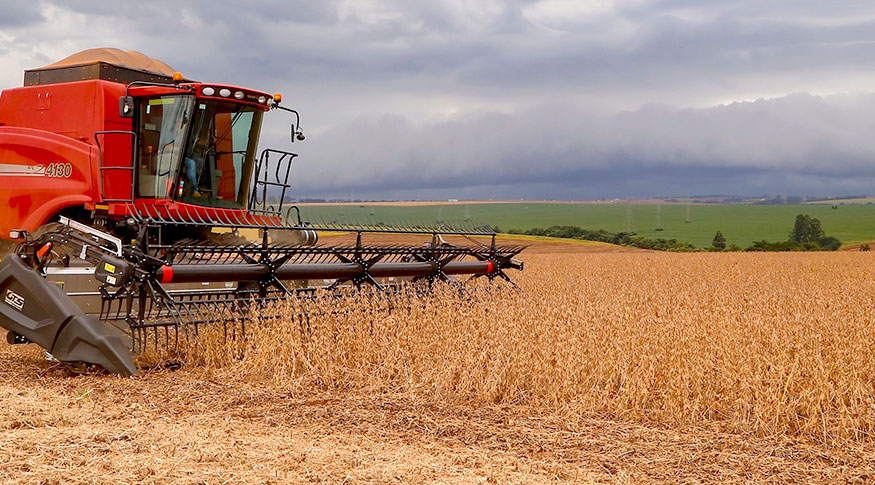Agricultural production
First estimate indicates record grain harvest in 2023 driven by recovery of soybeans
November 09, 2022 09h00 AM | Last Updated: November 10, 2022 01h40 PM

The Brazilian harvest of cereals and legumes is expected to reach 288.1 million tonnes in 2023, according to the first estimate of the Systematic Survey of Agricultural Production - LSPA, released today (09) by the IBGE. That figure means a new record in the time series that started in 1975 and represents an increase of 9.6% in relation to the 2022 estimates, or 25.3 million tonnes more.
The increase in production was mainly due to the bigger output expected for soybeans (19.1% or 22,783,143 tonnes), corn 1st crop (16.8% or 4,273,026 tonnes), upland cottonseed (2.0% or 82,558 tonnes), sorghum (5.7% or 160,057 tonnes) and beans 1st crop (4.9% or 53 514 tonnes).
“The increase was due to the recovery of crops affected in 2022, mainly soybeans, which faced losses in summer harvests in the states of Paraná, Rio Grande do Sul and Mato Grosso do Sul. Figures point to recovery; soybeans has an estimate of 142.2 million tonnes with an increase of 19.1% in relation to 2022. Losses in terms of corn crops have also been identified. Corn is expected to have a production of 114.5 million, an increase of 3.7%. We had a very good 2nd crop in 2022, a record in the time series,” says the manager of the survey, Carlos Barradas.
Decline in production was estimated in the case of rice (-3.5% or -374.380 tonnes), corn 2nd crop (-0.2% or -163.690 tonnes), beans 2nd crop (-9.5% or -124,796 tonnes), beans 3rd crop (-3.7% or -24 607 tonnes) and wheat (-12.1% or -1.155.066 tonnes).
Regarding expected area, positive changes are recorded by: soybeans (1.2%) and corn grain 1st crop (0.9%), and negative changes, by paddy rice (-4.1%), corn grain 2nd crop (-0.6%), sorghum (-1.5%), beans 1st crop (-1.4%), beans 2nd crop (-0.1%), beans 3rd crop (-0.5%), upland cottonseed (-0.1%) and wheat (-1.6%).
Paraná and Rio Grande do Sul record biggest increases
A bigger production is expected in Paraná (28.4%), Rio Grande do Sul (52.5%), Goiás (1.6%), Mato Grosso do Sul (8.4%), Minas Gerais (2.3%), Santa Catarina (15.2%), Tocantins (7.0%) and Rondônia (4.1%), and drops are estimated for Mato Grosso (-0.3%), São Paulo (-6.5%), Bahia (-3.3%), Maranhão (-2,4%), Piauí (-4.8%), Pará (-3.3%) and Sergipe (-0.1%).
Estimate for the 2022 harvest is 3.8% lower than that for 2021
The survey also released the October estimate for the 2022 harvest, expecting 262.8 million tonnes, 3.8% (or 9.6 million tonnes) more than in 2021 (253.2 million tonnes) and 0.3% (or 898,911 tonnes) above the September estimate.
As for the area to be harvested, the estimate is 73.3 million hectares, 6.8% (4.7 million hectares) more than in 2021 and 0.1% (51,991 thousand hectares) above the September estimate. Rice, corn and soybeans were the three main products in this group, and, together, represented 91.6% of the output estimate and 87.1% of the area to be harvested.
“Production of 262.8 million is a record in the time series as well as the production of corn (110.4 million tonnes) and of wheat (9.6 million tonnes). Soybeans was, once more, affected by climate problems in Paraná, Rio Grande do Sul and Mato Grosso do Sul, with lack of rain having an impact on productivity and causing an annual decrease of 11.5%,” Mr. Barrada says.
Against the previous year, the area for corn increased 10.%, being 6.8% in the first crop and 11.7% in the second, besides the rise of 4.8% in the area for soybeans and a decrease of 2.6% in the area for rice.
In terms of production, LSPA shows an increase of 15.2% for upland cottonseed, 22.6% for wheat and 25.7% for corn, with a decrease of 1.1% for corn 1st crop and an increase of 36.8% for corn 2nd crop. Soybeans decreased 11.5% and paddy rice, 8.1%.
Storage capacity grows 3.0% in the first semester of 2022
Also released today (09) by the IBGE, the Survey of Stocks showed a rise of 3.0% in the available storage capacity in Brazil in the first semester of 2021 against the previous semester, reaching 188.8 million tonnes.
Mato Grosso keeps the biggest storage capacity in Brazil, with 46.9 million tonnes. Rio Grande do Sul and Paraná follow, with 35.1 and 32.9 million tonnes of storage capacity, respectively.
As for the types of storage, the survey showed that the silos still prevail, having hit 96.1 million tonnes (50.9%) of the total storage capacity. They are followed by automated and bulk warehouses, which hit 70.0 million tonnes of storage capacity, and conventional, temporary and inflatable warehouses, with 22.6 million tonnes.
About the LSPA
Launched in November 1972 aiming at addressing the demand of users for monthly short-term statistical information, the Systematic Survey of Agricultural Production - LSPA provides estimates of planted area, harvested area, amount produced and average yield of products selected based on criteria of economic and social importance for Brazil. It does not only monitor each crop investigated in the calendar year of reference, from the intention to plant up to the end of the harvest, but also presents the harvest forecast for the coming year, with surveys in the months of October, November and December. LSPA is available at Sidra.
About the Survey of Stocks
The survey, which encompasses the entire country, aims at providing statistical information about volume and spatial distribution of stocks of basic agricultural products, as well as of the units where they are stored. The data raised by the Survey of Stocks are key to public and private managers and are related to food security issues. The information is provided by owners, expert employees or accountants of the establishments surveyed and is answered face-to-face, through telephone, email or online. The results are released every semester. LSPA is available at Sidra.




















